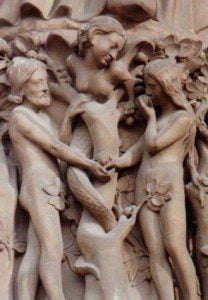We’ve been working through Denis O. Lamoureux’s book Evolutionary Creation: A Christian Approach to Evolution – a book that describes a way to move beyond the creation and evolutions debates. In Chapter 8 Dr. Lamoureux’s describes a Christian approach to human evolution proposing a way to reconcile scripture, Christian faith and doctrine, and what is known from science. The debates on science and faith hinge on issues that can be divided up into three basic categories (1) Sin and Death, (2) Sin and Accountability and (3) Atonement.
 Mixed into the whole discussion is a view of scripture and the appropriate interpretation of scripture as the inspired word of God. The understanding of scripture is a serious issue, and I don’t want to minimize it, but I think it has become such a serious issue because of the impact a view of scripture can have on the more important theological questions. The inerrancy and infallibility of scripture has become a rallying cry because the alternative appears to be apostasy, denial of God, denial of the redeeming act of God in Jesus, reduction of Christian faith to demythologized universal moral platitudes and ‘social justice.’
Mixed into the whole discussion is a view of scripture and the appropriate interpretation of scripture as the inspired word of God. The understanding of scripture is a serious issue, and I don’t want to minimize it, but I think it has become such a serious issue because of the impact a view of scripture can have on the more important theological questions. The inerrancy and infallibility of scripture has become a rallying cry because the alternative appears to be apostasy, denial of God, denial of the redeeming act of God in Jesus, reduction of Christian faith to demythologized universal moral platitudes and ‘social justice.’
The question for today then is a Christian approach to human evolution in the context of the message of faith contained in Gen 3, Rom 5-8 and 1 Cor 15 . Dr. Lamoureux proposes that the question of Adam and of the fall is incidental to the message of scripture in general and to the message of Paul in particular. It is incidental because it is part of an ancient understanding of origins. The true impact of Paul’s message is Christ looking forward, not his use of Adam or understanding of human origins.
Is it possible that Adam is incidental to the Christian story?
More importantly perhaps, is it possible that the fall is incidental to the Christian story?
What are the theological consequences?
Dr. Lamoureux frames his entire discussion in chapter 8 around the connection between sin and death. He argues for a baldly literal interpretation of Genesis implicit in Paul’s arguments in Romans 5. He argues for a completely literal intent in Genesis 2-3 by the original authors and editors. The incidental message of scripture is that sin and death entered through the sin of Adam. This incidental message is simply wrong – an ancient misconception of creation and the nature of the world. Perhaps the best way to look at Dr. Lamoureux’s approach is to quote the most significant passages.
A key to interpreting Paul’s sin-death passages is found in his theodicy. Stated precisely, he seamlessly interweaves the first revelatory stage of theodicy in Gen 3 with the New Testament fulfillment of theodicy by Jesus. To justify suffering and death in the world, he looks backward into the past sin of Adam. He has no choice but to accept the historicity of the events of Gen 3 since these were the historical facts-of-the-day for first century Jews. But more importantly, Paul focuses forward and views the harsh realities of life in the fulfilling light of Jesus. He introduces an eternal perspective on theodicy and justifies that “we may share in His [Christ’s] sufferings in order that we may also share in His glory.” (Rom 8:17; cf. 8:18; 2 Cor 4:16-17), and adds that “we rejoice in our sufferings, because suffering produces perseverance; perseverance, character; and character, hope” (Rom 5:3, italics added; cf. 8:24-25; see next subsection). Despite our struggles and pain, Paul concludes: “we know that in all things God works for the good of those who love Him, who have been called according to His purpose” (Rom 8:28). In other words, his view of theodicy is a combination of (1) the ancient history of Gen 3 and (2) the radical theological development in the New Testament that our afflictions have eternal meaning. (p. 325)
In the next paragraph:
The origin of suffering and death is cast in an ancient understanding of history with no correspondence to reality, while the fulfillment of these afflictions occurs in real history. Since this ancient history and theological development are tightly woven, it is quite natural for modern readers to link them and to view both as actual historical events. However, this conflates the ancient motif of a lost idyllic age with the most imporant event of history – the Incarnation. Christians today must separate the fulfillment of the biblical revelation on theodicy through Jesus from Paul’s ancient understanding of the origin of suffering and death through Adam. Failure to do so collapses incidental ancient categories with revealed eternal truths. (pp. 325-326).
This can be summed up:
To conclude, there is no sin-death problem. Adam never existed, and therefore suffering and death did not enter the world in divine judgment for his transgression. The origin of physical death presented in Gen 3 is rooted in ancient history and ancient science. Consequently, sin is not causally connected to death and no conflict exists between Gen 3 and the fossil record. To be sure, the solution proposed in this section is quite complex. But the divine revelation in Gen 3, Rom 5-8 and 1 Cor 15 is very simple: humans are sinners, God judges sin, and Jesus dies for sinful men and women. The sin-death problem is ultimately the product of a conceptual distance in the categories between inspired writers of Scripture and its modern readers. Christians today must identify the incidental ancient view of origins and separate it from the inerrant Message of Faith. Indeed sin entered the world, but not with Adam. (p. 329)
Dr. Lamoureux’s approach to the sin-death problem is summarized in the figure below:
And in conclusion Dr. Lamoureux recasts the famous statement of Galileo:
The Bible does not teach us how God made humans or how suffering and death entered the world, but that we were created in the Image of the Father, Son, and Holy Spirit, that He judges our sins, and that Jesus died on the Cross in order to forgive us. (p. 331)
Where does this leave us? I agree with Dr. Lamoureux that Adam, Eve, the snake, and ancient views of origins are incidental in the meaning of the text – the message of faith. But I have never found the connection between sin and death, especially all biological death to be persuasive. The idea of a cosmic fall and a change in the material nature of the world on account of such a fall is either incidental to the message – or a view resulting from a misreading of the text. It is not clear to me that Dr. Lamoureux’s insistence on a literal intent for the text of Genesis is quite right. Nor does this literalistic understanding of an idyllic age and a catastrophic fall seem quite fair to the range of ancient thought or to the range of thought in the first century. In particular it does not seem consistent with the book of Job, also a part of the Hebrew scriptures.
The Sin-death connection is a problem to be discussed, but I don’t see it as the central problem in a discussion of evolutionary human origins. Sin and Accountability and consequently Atonement are the key theological issues. Dr. Lamoureux’s proposal for a Christian approach to human evolution does not answer these. We simply have sinfulness as a fact of life, presumably a part of the way we were created. It seems to me that part of the message of faith is that God created humans for relationship with him, for relationship with each other, that humans willfully rebelled, and that rebellion has consequences. I don’t see where this fits in Dr. Lamoureux’s approach to Genesis or his approach to Paul.
The sin-accountability connection has consequences for the view of atonement. In Dr. Lamoureux’s approach we have the incarnation, crucifixion, and resurrection as facts – but it is not clear what was accomplished and why it was necessary.
This is an interesting book, a good step in thinking through the issues of scripture, theology, and human origins. In particular, the message-incident principle is a useful guide in thinking through the relationship between cultural assumptions and views of cosmology implicit in the text and scripture as inspired of God.
What do you think?
Is the fall – human culpability in rebellion – a part of the message of faith in Genesis and Romans?
Or is Dr. Lamoureux right, that scripture does not teach how sin and suffering entered the human experience?
It you wish to contact me directly you may do so at rjs4mail[at]att.net
If interested you can subscribe to a full text feed of my posts at Musings on Science and Theology.
For those who find the full book (400+ pages) somewhat daunting Dr. Lamoureux has condensed the book into a more accessible version, I Love Jesus & I Accept Evolution. He also provides audio and slide summaries of each chapter of Evolutionary Creation online.












